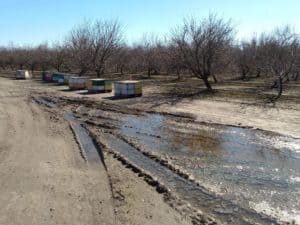
I don’t know what the groundhog did or saw this year, but according to the calendar it’s still winter. The first day of spring is still a month away. If you’re a pollinator or grower of almonds, you’re hoping weather conditions up and down the central valley of California become more favorable for flight activity than they have been. I recently returned from 2 weeks of inspecting and sampling colonies where conditions were cold, wet, and windy. These conditions delayed onset and slowed progression of the almond bloom and are forecast to continue. Frequent updates on the progression of bloom and conditions for flight are available from Blue Diamond.


In addition to the revenue from pollination fees, beekeepers also count on floral resources provided by the 1,000,000+ acres of almond trees that stretch roughly from Chico in the north to Bakersfield in the south. Many colonies get stimulated with feed prior to bloom to boost brood production and size. If there is not a smooth transition from supplemental feed to forage, because of inclement weather, colony growth can be hindered. If cool and wet conditions persist, many beekeepers may need to resume supplemental feeding to avoid starvation. The persistent wet conditions can also be problematic for growers and lead to increased application of fungicides which may be perilous to bee health.
Aside from the biotic implications for the bees, there are also practical difficulties for beekeepers. In the last few days there have been an abundance of photos and videos online of colonies submerged in orchards or swept away by flooding rivers. Some beekeepers have had truckloads of colonies get snowed in on mountain passes into the valley where wintery conditions have closed highways. At the very least, getting in and out of orchards to deliver or work colonies has been a muddy mess. With so much of the national herd sitting in one location, the implications of the current and near future conditions in the region may ripple across the country this season as colonies are dispersed post-pollination.